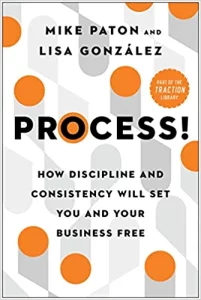Chapter 6 – Your Action Plan, page 117.
Commit
- Strengthening your Process Component is simple, but not always easy.
- When you are fully committed, it’s easier to lean into and even appreciate the inevitable challenges and obstacles that you will encounter.
- Expect people from every level of your organization to hold back, push back, or act out.
- Resistance to change is normal, especially when it involves rigor, discipline, and accountability.
- To succeed at this, you must believe in the power of this work with a firm resolve.
- When you sense resistance, listen carefully to what people are saying, seeking to truly understand where they are coming from, and why they feel so strongly.
- As Patrick Lencioni explained in The Five Dysfunctions of a Team, people can typically support a decision or initiative they originally disagreed with, but only when they feel heard.
- If your team is struggling to commit, share this book with them.
- If anyone remains reluctant or unsure, make it clear that you intend to move forward with this initiative, and that you need full support.
- Ask for everyone’s commitment to the process journey ahead, and get a verbal and heartfelt “yes.”
- False harmony is more dangerous than actual dissension.
3-Step Process Documenter
- Once you are firmly committed, you can quit discussing, debating, and procrastinating and start doing.
- For most companies, this takes about twelve months (give or take a quarter).
1. Identify Your Handful of Core Processes
- Meet with your leadership team.
- Debate and define your handful of Core Processes.
- Brainstorm, compile, and keep, kill, combine.
- Name each Core Process.
- Create a table of contents for the Core Process manual.
2. Document and Simplify Each Core Process
- Create a plan
- Observe
- Evaluate
- Document
- Simplify
- Review and Approve
3. Package the Core Processes
- Determine the right medium/format.
- Gather, organize, package, or store them.
- Name it (for example, The ACB Way).
- Make them easy to find and use.
- Complete the FBA Checklist
“You do not rise to the level of your goals, you fall to the level of your systems.” – James Clear, Power of Habit
Performing the Core Processes
1. Train
- Everyone who does one or more steps.
- Pick the right training method.
- Encourage candid dialog, even pushback.
- Verify understanding and commitment.
- Repeat yourself often (as necessary).
2. Measure
- Compliance – are we doing it right?
- Frequency – are we doing it often enough to get the desired results?
- Outcome – are we getting the results we want?
- Determine who, how, and where.
- Set goals.
3. Manage (or LMA)
- LMA (lead and manage in a way that drives accountability).
- Support team members as behaviors change.
- Reward and recognize great results.
4. Update
- As needed (at least annually).
- Engage the team.
- Streamline, automate, and simplify.
- Repeat checklist item 1, Train.
- Adjust the way you Measure and Manage, as needed.
- Important Disclaimer:
- Getting your core processes followed by using the checklist does not mean everyone will always follow the process or never make a mistake.
- It does mean that you have built a machine to drive accountability for following processes, getting results, and reacting more quickly and definitively when mistakes are made or goals are not achieved.
- Your work is never done. As the world evolves, your organization, its processes, and its people will evolve with it – faster and better than the competition.



